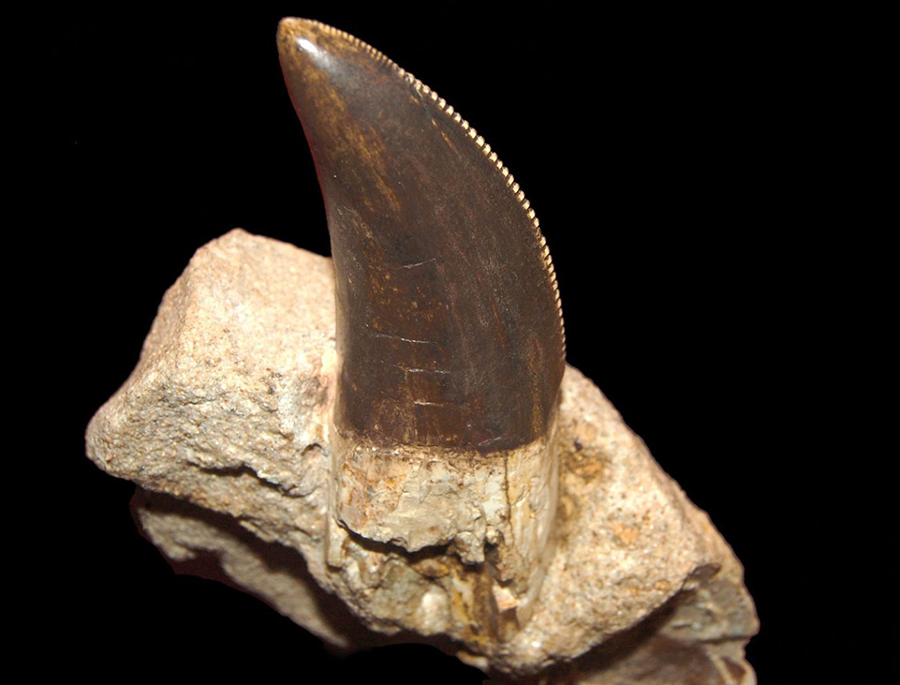Paleontological Surprise: Gigantic Predator Dinosaur May Have Arisen in Asia

Meet Siamraptor: Bigger than T. rex and cousin to allosaurs, a previously unknown, primitive form of Carcharodontosaurus was found in Thailand for the first time.
Before the great and powerful T. rex came the even greater and more powerful allosaurid offshoot known as carcharodontosaurus, a cousin of allosaurus but as much as four times bigger. Carcharodontosauruses were known to bite each other in the head and to have bedeviled North America, Europe and Africa.
Now the discovery of carcharodontosaurus fossils in Thailand, and a relatively primitive sort at that, suggests that this mega-predator with gigantic serrated fangs may have arisen in Europe – and Southeast Asia. The discovery of the carcharodontosaurus remains and the new origin theory were reported Wednesday by Dr. Duangsuda Cholchaloemwong of Nakhon Ratchasima Rajabhat University and colleagues in PLOS One.
The specimens found at the Khok Kruat formation in Thailand, dating to the Cretaceous period, were a previously unknown species of carcharodontosaurus that the team named Siamraptor suwati.
Siam means Thailand, raptor means robber and suwati is for Suwat Liptapanlop, a donor to paleontological research. Siamraptor apparently lived in a river basin, Cholchaloemwong tells Haaretz.

Although the Japanese-Thai paleontological team didn’t find a whole Siamraptor, they found a number of bone fragments from four individual specimens. Crucially, these included jawbones, vertebrae, and bits of hip, limbs and tail.
Given certain primitive characteristics relative to other carcharodontosaurus species, Siamraptor indicates that the clade may have evolved in the central-eastern parts of Laurasia – the northern supercontinent that encompassed the land masses known today as North America, Europe and Asia. Since carcharodontosauruses were found in North Africa – Niger, Morocco, Algeria and Egypt – an early type evidently also reached Gondwana, the even bigger supercontinent that encompassed the current Africa and Arabia, South America, Antarctica, Australia, and Indian subcontinent.
The origins of the great predatory dinosaurs are murky, because despite all their popularity, the truth is that not many specimens have been found, let alone good ones. Tyrannosaurs may have originated as much as 160 million years ago and at most (as far as is known) they could grow to 12 meters in length. In North America carcharodontosaurus and T. rex did coexist, Cholchaloemwong confirms – but in any case it seems the Carcharodontosaurus came first. And the biggest carcharodontosaurus, found in what is today North Africa (C. saharicus) could be as long as almost 14 meters in length.
The newly recognized Siamraptor is a basal species, though lived about 115 million years ago, apparently – well after the group arose. It was a mere eight meters long and three meters tall, Cholchaloemwong tells Haaretz. In this context basal means that Siamraptor’s split off very early from the rest of the carcharodontosauria, Cholchaloemwong says.

Big in Siam
In contrast to other mega-predators, carcharodontosaurus had a remarkable skeletal pneumatic system, the authors write – which turns out to mean, their bones were reminiscent of those of birds, which are characterized by air sacs.
This light skeleton may have meant that although the creature weighed about 7 tons, Carcharodontosaurus was nifty and could move fast, Cholchaloemwong says. We may never know who was the biggest at the Cretaceous ball, nor does it matter. All these species - Carcharodontosauruses, allosaurs, tyrannosaurs and giganotosaurs could eat you in a single bite and spit out your shoes.
But the cliché that it’s not a competition isn’t quite true. It was. Separate research estimated that because of their enormous size and appetite, each carcharodontosaurus would have needed about 500 square kilometers of territory. Numerous forensic studies detected deep bite marks on the skulls and bodies of the therapod monsters, including Carcharodontosauruses, that were apparently caused by other therapod monsters. In the case of inter-species aggression, the battles could have been over territory or in order to eat – there’s no rule that one dinosaur couldn't eat another. In fact some suspect the tyrannosaurus rex of being a cannibal.

Intra-species aggression could have been over territory, females, or – again – predation.
If these giants were biting each other for the sake of predation rather than to protect their territory, they would have had their work cut out for them. A study by Donald Henderson at the Royal Tyrrell Museum estimated that a carcharodontosaurus could lift a maximum of 424 kg (935 pounds) with its jaws – about the size of a grizzly bear. Or a half-grown hippo.
Wondrously, this dinosaur could open its mouth very wide, a little bit like snakes can, in its case thanks to loosely articulated jaw bones, all the better to bite its prey. Or each other in the head.
So if carcharodontosaurus came first and was bigger and entirely just as impressive, why does everybody and his dog know about the T-rex and allosaur, but not the carcharodontosaurus? Nomenclature, science, nomenclature. If you want your animal to be known, give it a name people can pronounce. Siamraptor fits the bill. Wait for it: Siamraptor vs Predator vs Alien.

Source: www.haaretz.com








